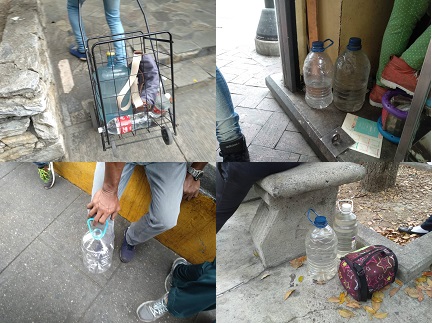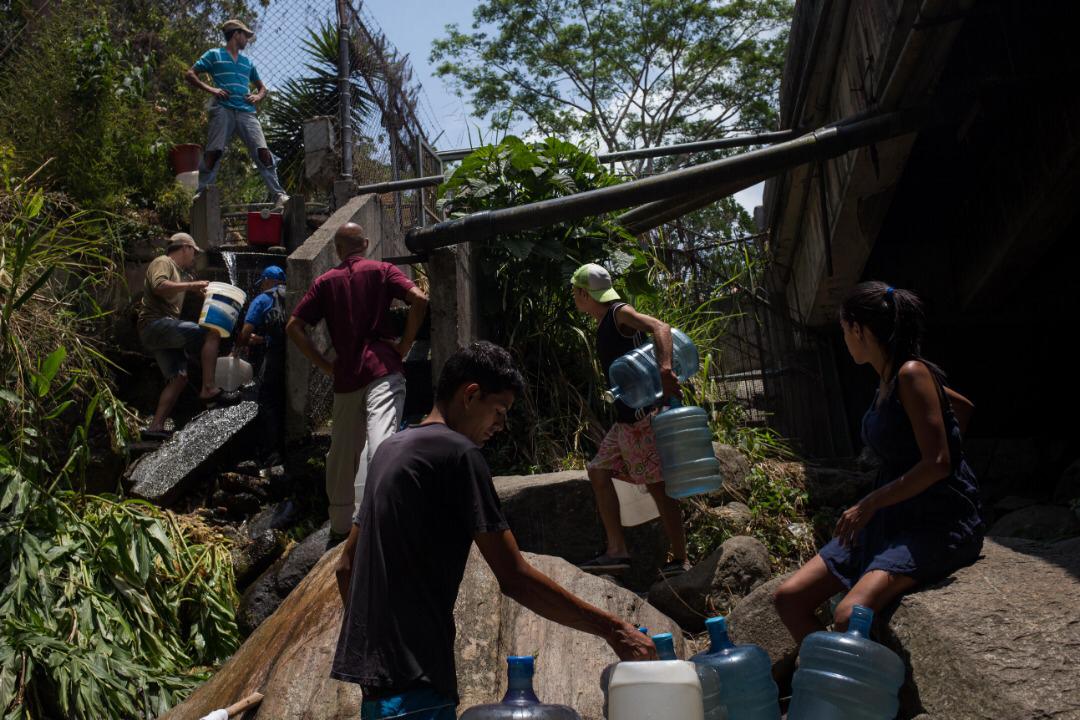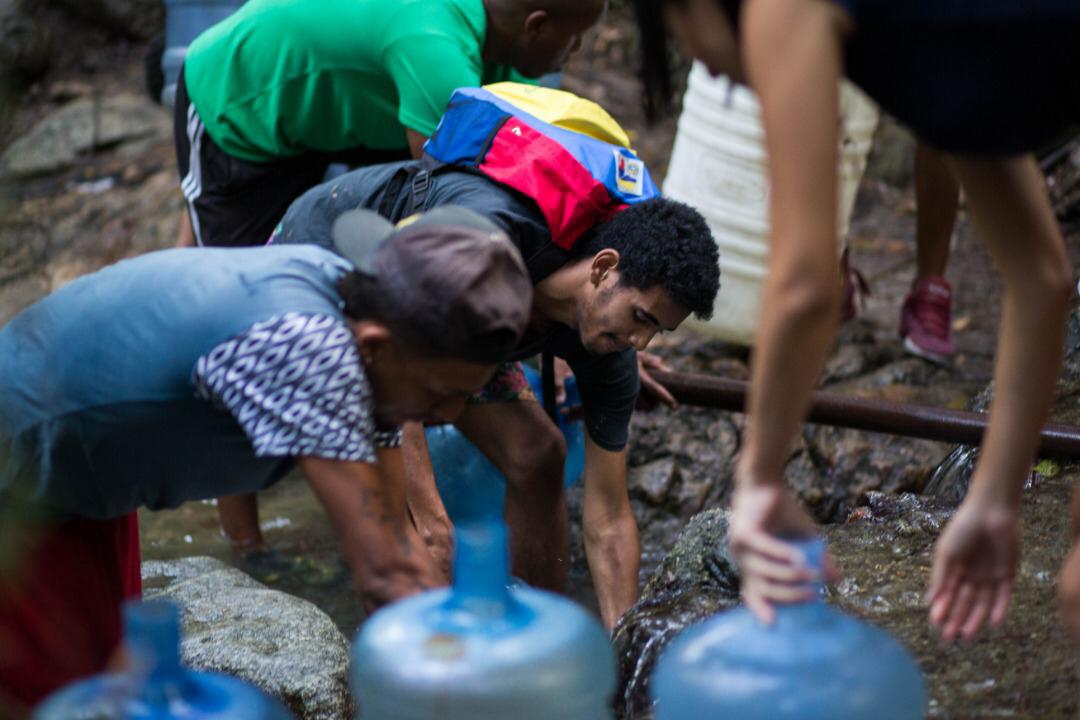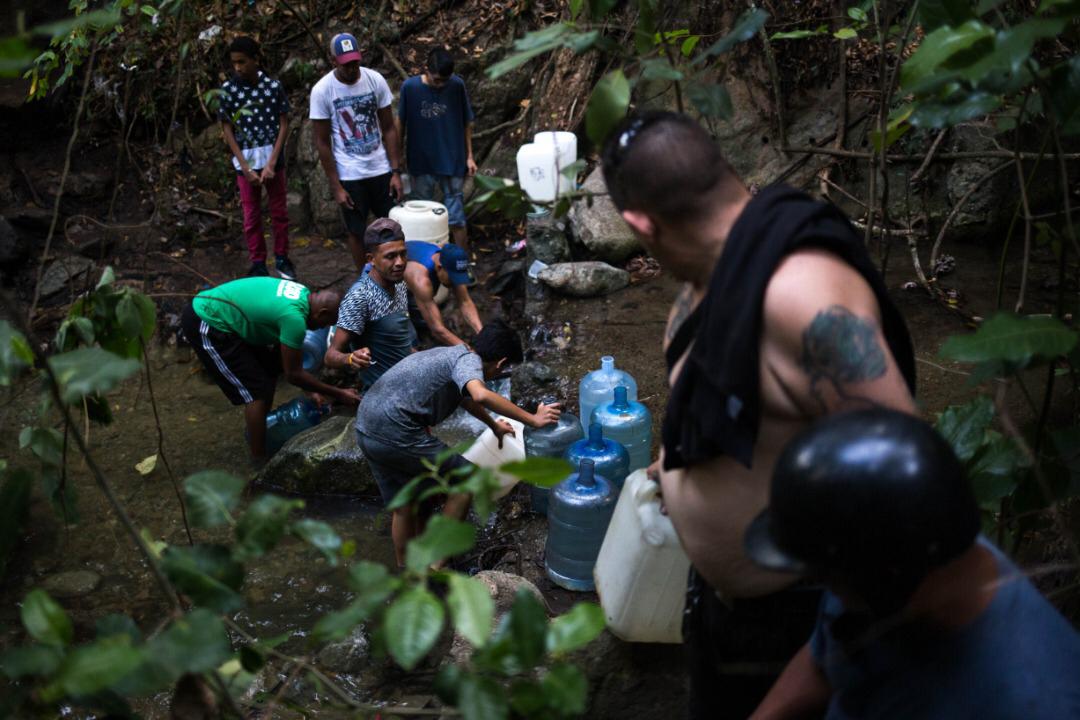Without Power, Venezuela’s Capital Ran Out of Water
The electric crisis has turned the massive infrastructure that Caracas needs to pump water, utterly useless. After a month without water through the pipes, the consequences of this man-made drought may soon outweigh those of blackouts themselves.


Photos: Arnaldo Espinoza
The recent series of catastrophic blackouts has managed what seemed impossible: make Venezuelans’ lives even more miserable. Power outages that last several days are the new normal around the country, including Caracas, a city that until not long ago, used to be somewhat spared from the electric crisis that has hit the country for over a decade now. With the utter collapse of the National Electric Network, misery reached the capital, maybe even worse than in other cities.
Social media is full of people waiting for hours to get some water, bathing at flooded potholes on highways, protesting and therefore facing repression.
While also hit by prolonged blackouts, most of Caracas (a city of at least 3,5 million people) hasn’t received a single drop of water since March 7th, the day of the first hundred hour-long blackout. The reason is that Caracas is spread over a valley at 900 meters above sea level, surrounded by mountains; given that topography, the water that comes from the Camatagua dam and the Tuy river in the lowlands south of the capital must be pumped uphill, and that requires, you guessed it, electricity! According to civil engineer and former president of Hidrocapital, José María de Viana, 600 MW are required only to start the Tuy pumping system.
 New normal: everyone in Caracas is either on their way to find some water, or carrying it under the sun. Photos: Gabriela Mesones Rojo
New normal: everyone in Caracas is either on their way to find some water, or carrying it under the sun. Photos: Gabriela Mesones Rojo
“I live in the Misión Vivienda complex from Avenida Victoria,” says Anabell, a 22 year old mother who just lost her job due to the blackouts. “We have a tank, but it’s useless without power. So all the neighbours go down and fill their buckets, we carry ours for 13 floors. I hadn’t thought about it, but someone told me the other day that we’re all contaminating the water of the tank with our filthy buckets.”
Caracas isn’t the only city with this problem. Maracaibo and most of the center region in the country also need electricity to pump water through pipes, and in an interview to Prodavinci, de Viana explains that 10% of all the electricity produced in Venezuela is consumed in these pumping systems.
The Tuy system (never halted for this long since its construction in 1953) is still off because its power consumption would collapse the extremely fragile network that barely provides power to the country for a few hours a day. Caracas’ subway began working this Tuesday for the same reason. So even though the capital gets an irregular power supply, almost no water runs through its pipes.
 Most pick up water from the Avila, a majestic mountain with mineral untreated water waterfalls.
Most pick up water from the Avila, a majestic mountain with mineral untreated water waterfalls.
Those who can afford it, pay up to $200 for a 5,000 litre water truck to fill their built-in tanks. Others resort to extreme measures, like picking severely polluted water from sewage draining into the Guaire river. But beyond the serious health problems this could cause, those sewers could soon run dry too. According to de Viana, some hundred liters per house are required to move human waste through the sewer system. Without water pumping, sewers will dry up, and all the waste will pile up inside, creating yet another public health catastrophe.
We’re talking about cooking with polluted water. About a possible cholera outbreak. Nutritionist Susana Raffali warned that diarrhea can kill a kid in just a few days, faster than hunger.
“People from Cotiza go to a pipe in the Cota Mil for water,” says Iraima, a 57-year-old nurse from Cotiza. “We get it from a construction site, but the water has a strange white dust that you can only see when it settles. It’s the nearest option we have, but we still have to walk two blocks to get there, carrying all that weight under the sun. It’s dangerous to cross the highway, and I’ve seen many children do it these past few days. It usually takes us about two hours to go there, wait in line, and fill our bottles. And this is only for washing stuff, if we want cooking or drinking water we have to find it somewhere else.”
 While some pick up mineral water from the mountain, others resort to extreme measures, like picking severely polluted water from sewage draining into the Guaire river.
While some pick up mineral water from the mountain, others resort to extreme measures, like picking severely polluted water from sewage draining into the Guaire river.
As you can imagine, the situation in hospitals is even worse. In 2016, a study in India showed that an average hospital of 200 beds, could consume more than 1,000 liters of water per patient, per day. Hand-washing and toilet flushing alone represent around 42% of the total. A survey from last year revealed that 79% of Venezuelan hospitals already lacked a regular water service, so imagine how bad it is now. Without water, keeping fairly acceptable levels of hygiene becomes impossible, things as simple as washing your hands or keeping patients clean become monumental tasks; a recent study from the UN identified poor sanitation in hospitals as one of the main drivers behind the development of antibiotic resistance, and ORs, laboratory services and even kitchens can paralyze completely after enough time without running water.
The government’s response so far has been as mediocre as expected. On a mandatory broadcast on national TV (which most of the country missed because there was no power), Nicolás Maduro announced he would send water trucks to sectors of Caracas. The Tuy system pumps 15,000 liters of water per second, which means Maduro would have to provide at least three trucks, every second, continuously, to keep up with the requirements. Good luck with that.
According to de Viana, the consequences of having a city as big as Caracas without a single drop of water may soon outweigh those caused by the blackouts. And without any hope of reversing the electric crisis anytime soon, those consequences seem unavoidable.
Caracas Chronicles is 100% reader-supported.
We’ve been able to hang on for 22 years in one of the craziest media landscapes in the world. We’ve seen different media outlets in Venezuela (and abroad) closing shop, something we’re looking to avoid at all costs. Your collaboration goes a long way in helping us weather the storm.
Donate





